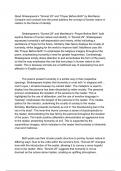Read Shakespeare’s “Sonnet 29” and “Prayer Before Birth” by MacNeice.
Compare and contrast how the poets address the concept of human nature in
relation to the theme of identity.
Shakespeare’s “Sonnet 29” and MacNeice’s “Prayer Before Birth” both
explore themes of human nature and identity. In “Sonnet 29”, Shakespeare
expresses humanity’s self-deprecation and misery, whilst indicating a
semblance of hope for the future. Similarly, Mac Neice displays the cruelty of
humanity, whilst begging for the world to improve itself. MacNeice uses the
title “Prayer Before Birth” to emphasise the religious imagery throughout the
poem, emphasising humanity’s need for greater forgiveness. Contrastingly,
Shakespeare simply draws attention to and accentuates the form of the poem,
so that he may emphasise the role that love plays in human nature to the
reader. This is because sonnets are a traditional way of expressing love and
affection in English poetry.
The poems present humanity in a similar way in their respective
openings. Shakespeare implies that humanity is cruel with “in disgrace with…
men’s eyes, I all alone beweep my outcast state”. The metaphor is used to
display how the persona has been discarded by wider society. The personal
pronoun emphasises the isolation of the persona to the reader. This is
highlighted by the use of alliteration, and the use of emotive language in
“beweep” emphasises the despair of the persona to the reader. This creates
pathos for the narrator, underlining the cruelty of society to the reader.
Similarly, MacNeice presents humanity as evil in “the bloodsucking bat or the
rat or the stoat”. The inner-line rhyme conveys a sense of claustrophobia to
the reader, demonstrating the fear felt by the persona throughout the duration
of the poem. The harsh positive alliteration demonstrates an aggressive tone
to the reader, presenting humanity as evil. This is supported by the
superstitious imagery, which indicates to the reader that humanity is inherently
cruel and malicious.
Both poets use their chosen poetic structure to portray human nature in
differing ways. Due to the volta within the sonnet’s form, “Sonnet 29” changes
tone with the introduction of the sestet, allowing it to convey a more hopeful
tone to the reader. Here, “Sonnet 29” suggests that humanity is not as
doomed as the octave alone implies, creating an uplifting atmosphere.
, Contrastingly, MacNeice uses an irregular structure, with the stanzas
increasing in length throughout the first half of “Prayer Before Birth”. This
demonstrates a feeling of cumulative desperation to the reader, which is
reflective of MacNeice’s own feelings, having lived through two world wars.
This experience inspired the decidedly more negative tone of “Prayer Before
Birth”.
However, despite this clear difference, both poems explain the concept
of being destined for pain in humanity. Shakespeare implies in the octave that
mankind is doomed for discontentment. This is clearly demonstrated to the
reader in “desiring this man’s art and that man’s scope”. The use of the
determiners implies to the reader that the fate of the persona is to consistently
envy the talents of others, indicating to the reader that mankind will inevitably
experience self-loathing in life. Likewise, MacNeice demonstrates to the
reader that human nature is predetermined. This is displayed through “parts I
must play… lovers laugh at me, the white waves call me to folly”. MacNeice
uses the imperative to demonstrate to the reader how humanity has no choice
in its future. The metaphor implies to the reader that mankind’s fate is
determined, and that man is predestined to achieve misery. This creates a
melancholy tone, and the alliteration emphasises the cruelty and pain that
must be endured to the reader. Moreover, the repetition of the personal
pronoun “me” demonstrates the pain of the persona, evoking a sense of pity in
the reader. Therefore, both poets succeed in demonstrating that human nature
involves inescapable sadness.
However, the poems present contrasting meanings in their conclusions.
Shakespeare indicates that human nature involves joy with “Yet in these
thoughts… almost despising / Haply I think on thee”. The modifier “yet”
indicates a change in tone to the reader. This is supported by the juxtaposition
between the respective connotations of misery in the verb “despising” and the
joy implied to the reader in the adverb “haply”. This juxtaposition underlines
the change in mood to the reader, emphasising that human nature involves
both sadness and passion. Differently, MacNeice uses his closing stanzas to
indicate that humanity lives an emotionless, passionless existence. This is
seen most clearly in “make me a cog in a machine, a thing with / one face, a
thing”. The extended metaphor demonstrates to the reader how humanity will




